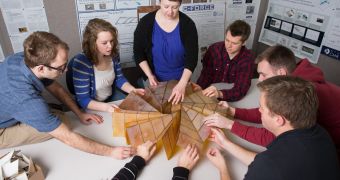A group of mechanical engineering students at Brigham Young University (BYU), working with scientists from the NASA Jet Propulsion Laboratory (JPL), in Pasadena, California, have enlisted the help of an origami master to create foldable solar arrays that can unfold to several times their stored size.
The sad reality of space exploration is that it is very expensive to launch something into space. Prices go even further up when the satellites in question are bulky, as it is increasingly often the case. With the new solar arrays, spacecraft will be deployed farther from Earth, and still be able to produce electricity.
The purpose of the origami-inspired solar arrays is to be able to fold them in a configuration that takes up very little space. In the first study of its kind to date, researchers were able to create a configuration where the unfolded solar panels are nearly 10 times their stored size.
Rigid silicon solar panels are admittedly more difficult to fold properly than thin sheets of paper, but the scientists and students involved in the research were able to make that happen with the help of internationally-renowned origami expert Robert Lang.
“It’s expensive and difficult to get things into space; you’re very constrained in space. With origami you can make it compact for launch and then as you get into space it can deploy and be large,” says BYU professor Larry Howell, who was the leader of the research team at the university.
Details of the new approach were published in the November issue of the Journal of Mechanical Design. The work was made possible by a $2 million (€1.45 million) grant Howell received from the US National Science Foundation (NSF), back in 2012.
“It’s hard to predict what the greatest outcome of this collaboration will be, but it would be a great success if a solar array based on our concept flew on a NASA mission,” says Lang.
The first prototype the team developed contains solar arrays that can be folded to a diameter of 2.7 meters (8.9 feet). When fully deployed, the arrays are 25 meters (82 feet) across. In the end, the team wants to be able to produce an array capable of producing 250 kilowatts of power.
To get a sense of just how much energy that is, consider that the entire International Space Station is currently running on 84 kilowatts of electricity produced by its onboard solar arrays.
“Space is a great place for a solar panel because you don’t have to worry about nighttime and there are no clouds and no weather. Origami could also be used for antennas, solar sails and even expandable nets used to catch asteroids,” Howell concludes.

 14 DAY TRIAL //
14 DAY TRIAL //